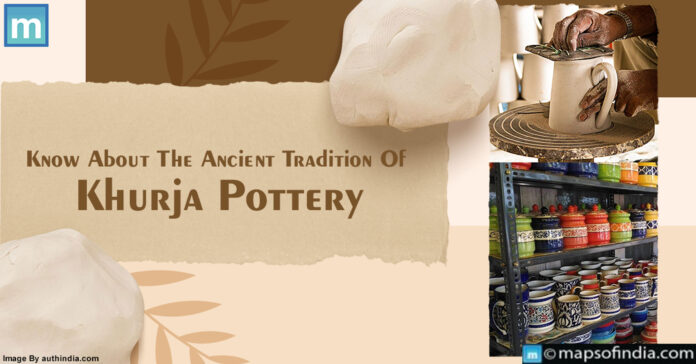Khurja is a small town located on the humble streets of the Bulandshahr district of Uttar Pradesh. It is renowned across India for its exquisite pottery craftsmanship. The ancient town shelters the most skilled potters, who have made a livelihood out of the art descended through generations—more than seven centuries of passing a legacy from one generation to the other. Even with civilisation and generation change, Khurja craftsmen still defend the 700-year-old culture presented in ceramics. The following discussion is an eye-opener to the traditional tales of Khurja pottery.
Discovering Khurja: The Town of Pottery Magic
Walking into Khurja feels like arriving in a busy clay studio. The town’s winding alleyways are filled with a brightly coloured selection of ceramic stores and workshops bustling with artisans shaping and painting pots. The place caught its creative breath in the 14th century under royal patronage, propelling it to become a pottery production powerhouse.
The town’s heritage persists in some of the state’s most magnificent crockery, and its vocation has been passed down through generations of potter families. Khurja is one of the most vibrant pottery trading destinations in Uttar Pradesh. It offers the city a mix of boldly coloured patterns from Italian painter De Cambrai and Netherlandish sculptural methods.
Journey Through Time: Khurja’s Pottery Legacy
According to oral folklore, local potters are descendants of the nomads who began to settle here more than seven centuries ago. At the same time, archaeological excavations reveal clay artefacts originating in the Kushana period of the ancient Indian civilisation. However, it is commonly believed that Khurja’s ceramic glory began in the Tughlaq era when many accomplished potters joined the settlements and factories.
The Mughals discovered the potential of Khurja pottery and created conditions for its development. Over time, the community developed unique styles and decorations that were imitated in towns throughout northern India. Regardless of the shifts in modern trends, the local workers trained their craft generation after generation, motivated by hard work.
Crafting Beauty: The Art of Khurja Pottery
Meticulously crafted pottery khurja’s essence is its wondrously careful creation. Potters of the unique ceramic clay, whose expertise is transmitted through apprenticeships exclusively in this region. They craft pots of it either on an exceptional potter’s wheel or without it – building clay by hand, carving hard themes to perfection.
After shaping, they layer glaze and paint their art, depicting intricate patterns and scenic motifs on their work, taking inspiration from the living world. Then comes a skillful firing process in a carefully maintained kiln that gives their creations life. There are no shortcuts possible with Khurja’s pottery, and the creation of each singular piece shows the potters’ genius and love for their trade.
From Clay to Masterpiece: The Making of Khurja Pottery
Observing the raw clay’s journey to the finished pot can be interesting. First, the clay is dug from the designated Khurja mines, then thoroughly cleaned and kneaded into a mixture to extract impurities that will be refined into a pliable dough. The potter shapes the pots with the help of a wheel or spinning wheel, with the walls of the pots raised.
Once pots have dried to a leather-hard state, they get the design stencilled onto them using natural glazes and paints, crafting patterns in bright primary shades. Instead, decorative patterns are breathed into life with the assistance of designs handed down over many generations. The final firing at 900 to 1,000 degrees Celsius completes transforming clay into sturdy ceramic utilisation and art. Each process necessitates a unique skill that takes a lifetime to acquire.
Preserving Tradition in a Modern World
Mass production threatens this centuries-old craft in Khurja even when there is demand worldwide. However, government bodies and the Khurja Pottery Institute have initiatives to help protect their artisans, who are exposed to training and new methods, such as designer pottery fusions. Cooperatives also support marketing unique pieces that have helped potters sustain their livelihoods and various heritages.
Additionally, young people are slowly beginning to see the economic sense in this heritage and thus taking it up despite current trends. However, old techniques still hold sway over this town’s creativity. Properly facilitated, the people of Khurja can continue being creative and preserving their century-old history, which will be held in high regard worldwide for many upcoming years.
Exploring Khurja: A Cultural Experience
A trip to Khurja is entire of sights of a quintessential pottery town where the life of many village residents is filled with clay-coated homes, thriving workshops, and boisterous bazaars. Watching the demonstrators or the master craftsmen shows how skilled they are. Moreover, watching the showrooms allows you to appreciate and touch the skilled throwers who give you insights.
The Khurja pottery tradition, which has prevailed for over seven centuries and dates back to the Tughlaq dynasty, expresses India’s rich cultural background. By promoting native arts and crafts like Khurja pottery, those traditions can be passed down to future generations for all to appreciate.




